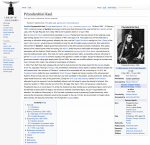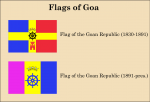European colonization in the region of South Africa began with the Dutch under the VOC in 1652. Fights with colonial authorities, as well as smallpox epidemics, would cause the collapse of the native Khoisan population. Dutch influence promptly expanded rapidly over the Cape, and in particular the semi-nomadic Trekboer culture emerged over the eighteenth century. Much of this Dutch population was increased further with the migration of Huguenot refugees. Slaves and unfree labour was imported from India and particular the Malay world. By 1795, Dutch rule was well-established in the colony.
With the Batavian Revolution in 1795 resulting in the establishment of the modern Dutch state, Cape Dutch resentment of the corrupt VOC rule of the colony resulted in the proclamation of independent republics of Swellendam and Graaff-Reinet. The French alignment of the Batavian Republic, however, would result in a British invasion of the Cape Colony. This conquest proved swift, and it conquered Graaff-Reinet and Swellendam as well. Subsequently, as the Cape frontier moved east of the Great Fish River to meet Bantu Xhosa peoples, this drew the British forces into a war with the Xhosa to the east, which ended with the Xhosa being driven beyond the Great Fish River.
Following the end of the French Revolutionary Wars in 1804, the Cape was returned to the Netherlands, or rather the new Batavian Republic. It subsequently appointed Jacob Abraham Uitenhage de Mist to the position of Commissioner-General. In this post, he pushed for a series of reforms. While the Dutch Reformed Church retained some official status, the Rights of Man, including religious liberty, became enshrined in the new colonial charter. De Mist, who regarded the Cape Dutch as semi-barbaric, reduced the size of the northern frontier to prevent "barbarization" and he also brought in a number of immigrants from the Netherlands, as well as some from the French ports of Anvers and Bruxelles. This gave the Cape, for the first time, small Catholic and even Jewish minorities. Most famously, he declared the gradual abolition of slavery, with all slaves born on or after 1807 free from birth. In practice, this had little effect outside the district seats and the area around Kaapstad, and many on the colonial council made clear their displeasure. The importation of indentured servants from Java would ultimately have a much greater effect on slavery's economical position. Despite being averse to expansion, settler encroachment on the eastern Zuurveld border resulted in a war with the Xhosa which ended with Dutch forces driving the Xhosa off of the land beyond the Great Fish River. He subsequently brought in a high number of settlers from the French region of Flanders; their Catholicism subsequently caused sectarian tensions which hampered attempts at making an eastern bloc for years to come. In 1819, he resigned from office and returned to the Netherlands. However, in 1823, with war with France, its sister republics (including the Batavian Republics), and Britain would result in a second British occupation. In this period, British control proved heavy, which caused Cape Dutch fleeing their authority to flee to the northern frontiers, and a republic was even declared in Uitenhage before it was occupied. However, in 1827, Britain fell into revolution; the revolutionary regime promptly sued for peace and returned all colonies to the Dutch. After all, in 1810, British forces create a naval base on the way to India; this the British was retained in the peace settlement.
With the Cape returned to Dutch hands in 1828, the new Commissioner-General, Godert van der Capellan, set out to establish his own plans. He established the town Barnevelt, named after the seventeenth-century Dutch republican martyr, near the British-constructed Fort Frederick. After another Dutch-Xhosa War, the landdrost of Barnevelt Andries Stockenström established a treaty system with the Gcaleka Xhosa which was aimed at ensuring an end to the great warfare. With De Mist's manumission made a pure joke outside the region near Kaapstad and the district seats, in 1837 slavery was declared abolished across the Cape Colony, although he also made moves to increase importation of Javanese indentured servants to ensure there would be a continued supply of unfree labour. This subsequently caused the long-running wave of settlers to the region then known as Transorangia, between the Gariep (then known as the Orange) and the Vaal rivers, to turn into a surge to turn into a great wave; with Shaka Zulu's campaign of conquest having caused deep amounts of chaotic strife, these settlers were able to establish the Transorangia Republic. This was met with horror from Kaapstad, and when news of this got to The Hague, it sent a great military force aimed at taking over Transorangia; it swiftly did so, renaming the town of Pieterburg to Wittenstad after the seventeenth century Dutch republican martyrs Johan and Cornelis de Witt, and there they established the District of Wittenstad. This, notably, gave the Dutch a theoretical border with the British colony of Natalia.
In 1810, British forces established a port then known as Port Charlotte. This settlement grew into a town with the help of Irish penal labour that would otherwise have been diverted to Australia; some of them fled to the increasingly chaotic interior. This port declined after the second British takeover of the Cape; following the British Popular Revolution, many of the convicts had their sentences commuted and Port Charlotte was renamed after the British constitutionalist martyr John Hampden. In 1839, in return for assisting, him, the Zulu king Dingane gave the British a colony now christened Natalia. Further settlement, mostly consisting of Irish settlers but also of refugees fleeing Zulu expansionism, grew Natalia's population. With the Dutch having conquered Wittenstad, there was now a theoretical border between the Dutch Cape Colony and Natalia. As relations between the British Isles and the Batavian Republic worsened over the 1840s and 50s over the Malay archipelago, this led to fears of war.
In both Natalia and the Cape there grew a lobby advocating expansion, in the Cape over expanding into Xhosa, or "Cafre", lands, in Natalia into Xhosa and Zulu lands. Such sentiments led to Anglo-Xhosa Wars which ended with the Rharhabe Xhosa, along with the related Pondo and Bhaca, becoming effectively suzerain to the authorities in Hampden. Only the king of the Basotho, Moshoeshoe I, retained his independence by skillfully playing the Dutch and the British off one another. There also grew movements advocating self-government; in Natalia, the existing Parliament won responsible government after a lengthy campaign, while in the Cape Colony the existing colonial council was expanded into a formal legislature. In the Cape, the influence of republican ideals of citizenship from the metropole and the colony's solid white and mixed-race majority led to a non-racial franchise, while Natalia's solid black majority led to a property franchise that was in practice racial.
In 1871, diamonds were found in what was then the Bastaard (mixed-race) independent republic of Bastaardland, resulting in a great wave of Dutch settlers who promptly overthrew the Bastaard government and petitioned for integration into the Cape; promptly, this wave only increased. A town, named Paulustad, named after the first head of state of the modern Batavian Republic, emerged near the great new diamond mine. This rush would be outmatched by a gold rush in 1883 in the area just beyond the Vaal River in territory nominally claimed by the Portuguese. Settlers, who were mostly Dutch, Irish, and Portuguese in origin, clamoured for various governments in difference; with the recent rapprochement between Britain and the Netherlands, the two nations acted as one force to force the Portuguese government to recognize a condominium in the region named Ouroria after the Portuguese word for gold,
ouro.
In the German Unification War (1880-1884), the Batavian Republic made the shocking decision of breaking with its old ally of France and declaring its neutrality aligned with the British Isles. France suddenly lost its main port between the metropole and its colonies of Formosa and Cygnie. It immediately aligned itself with the Zulu, struggling to maintain its independence in between Portuguese and British pressures, giving it a large number of arms in return for control over Sainte-Lucie and Boulanger. France being incapable of projecting power across the Zulu kingdom from its small ports helped it to maintain its independence. A new factor was added to South African affairs - a French presence.
With the Netherlands facing an aggrieved internal crisis, including political violence, over the 1880s as a result of its controversial breaking of its alliance with France, it strengthened the hand of advocates of colonial autonomy, and in 1888 the Dutch government accepted the right of the colonial council to appoint a Commission to govern over internal affairs. Even with this power, the multi-racial franchise was maintained, in no small part because, with the exception of the east where Bantu peoples who increasingly spoke Dutch made solid pluralities and majorities, whites and mixed-race peoples made a majority everywhere; as such, multiracial suffrage only meant a handful of black legislators. Yet, at the same time, in Natalia, the suffrage question proved far more controversial due to the colony's solid black majority; a variety of laws known as the Penal Laws of Natalia rendered black people increasingly second class citizens. However, this drew ire from the Irish population, many of whom remembered how their ancestors suffered under penal laws. This caused decades of tumult as the suffrage question proved to be a polarizing issue.
In the 1930s, following the disaster that was the Hindustani War of Independence, the British Isles proved reluctant to hold its colonial empire. As such, when the eastern Xhosa made motions for independence, the British let them. Such waves also impacted the Cape Colony, which now made its unofficial independence official; with the Gcaleka Xhosa free from the grasp of the Dutch, Xhosa nationalists finally succeeded in creating a unified Xhosaland (since renamed KwaXhosa). In Natalia, the suffrage question was finally resolved after decades of tumult, with universal suffrage a reality in 1948; desirous of making a new future on its own, in 1952 this new multiracial democracy declared its independence.
Today, the nations of South Africa stand; despite problems with development disparities, unresolved racial issues, and other inequities, they are intent on meeting the future and triumphing over its issues.













